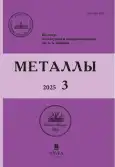编号 3 (2025)
Articles
Wear resistance of corrosion-resistant austenitic high-nitrogen steels 05kh22ag15n8mf and 02kh22ag10n4mf in a cryogenic environment
摘要
 5-13
5-13


Analysis of lead and zinc selective extraction process from EAF dust during carbothermic reduction
摘要
 14-31
14-31


Features of microstructure formation during continuous aging in granulated nickel-based alloys
摘要
 32-41
32-41


Mechanochemical synthesis of ni/hfc composite structures
摘要
The structural-phase evolution of the mechanochemical formation of Ni/HfC mechanocomposites containing 50 and 70 wt.% nickel was studied using X-ray diffraction analysis, scanning electron microscopy, and energy dispersive spectroscopy. It has been shown by X-ray diffraction analysis, that during mechanochemical synthesis in a ternary mixture of elemental powders Ni, Hf and C at a stoichiometric ratio of Hf and C, the formation of hafnium carbide occurred already after 40 s. For both compositions, the crystallite sizes of the nickel rapidly decrease upon mechanical activation for up to 4 min compared to the initial. Intensive formation of hafnium carbide is recorded during mechanical activation with duration of 4–8 minutes. With mechanical activation for 12 and 20 min, the processes of secondary structure formation lead to homogenization of the product and depletion of hafnium carbide in carbon to the composition HfС0.5.
 42-49
42-49


Microstructure and mechanical properties of Cu-Cu2O composites produced by hot pressing of copper powder
摘要
The article presents results of studying microstructure and mechanical properties of a composite material (Cu-Cu2O). The samples were taken from copper electrical contacts for electric welding machines manufactured by hot pressing PMS-1 powder under of «Uralelectromed». The microstructure was studied using scanning electron microscopy and scanning probe microscopy. The mechanical properties were determined by nanoindentation using the authors’ technique, which involves converting the indentation diagramF(h) into the tensile diagramσ(ε). Metallographic studies have shown a small grain size (~10 μm), the content of cuprite Cu2O inclusions of ~1 μm in size with faceted morphology was close to 20%. The results of measuring the mechanical properties: Young’s modulusE= 119.89±5.75 GPa, hardnessHIT= 2.28±0.15 GPa; elastic recovery of the materialR= 5.54±2.33%; plasticity characteristicδА= 94.46±2.33%; yield strengthσт≈ 600 MPa. Evaluation of mechanical stresses due to the two-phase nature of the composite material Cu-Cu2O showed that the additional pressure, related to the length of the rupture line, is approximately 50 times greater than the external force, and this can be the main reason for the failure of the products.
 50-60
50-60


Mechanism of the Zr-V Alloy Nitridization Process
摘要
A sequence of structural transformations characterizing the high-temperature nitridization of a zirconium-vanadium bimetallic billet has been established. The mechanism of nitridization of zirconium-vanadium alloy ZrV2, which is formed during the manufacture of a bimetallic workpiece by electric arc welding, has been established. During high-temperature interaction with nitrogen, the alloy disintegrates, the basis of which is ZrV2intermetallic compound, with the formation of stoichiometric zirconium nitride ZrN, solid nitrogen solutions and compounds of the composition ZrхVyN1–х–ywith simultaneous segregation of vanadium at the grain boundaries of zirconium nitride. The released vanadium diffuses into the area of a solid solution of zirconium with nitrogen in the individual zirconium, forming a solid solution of the composition ZrхVyN1–х–y. The final products of nitridization at the selected temperature are ZrN and Zr0,3V0,6N0,1. Ceramics is a composite consisting of grains of stoichiometric zirconium nitride distributed in ZrхVyN1–х–ywith a limiting composition of Zr0,3V0,6N0,1.
 61-70
61-70


Modeling of dissolution of oxide phases zirconium and hafnium in acid solutions
摘要
 71-76
71-76


Calculation of the degree of blackness of metallic melts based on the data of technological control of temperature and time during the melting of structural steel grades
摘要
 77-87
77-87


Determining the service life of a metal shell structure using a neural network
摘要
 88-96
88-96


Features of the influence of alternating elastic-plastic deformation on the mechanical properties of metallic materials
摘要
The study of the effect of elastic-plastic alternating deformation on the mechanical properties of magnesium strips and low-carbon steel strips after processing on a roller straightening machine was carried out. The application of the strengthening process in 1 and 3 passes does not change the geometry of the strips. The yield strength of steel increases and the yield strength of magnesium decreases; at the same time, the yield plateau disappears on the tensile curve of steel samples, and a region similar to the easy slip stage in a single crystal appears on the tensile curve of magnesium samples after the elasticity stage. For an integral assessment of the effect of alternating deformation on the material and to determine its resistance to deformation, flow curves were constructed using the Nadai model.
 97-103
97-103


Improvement of technological properties of metal alloys by nonmonotonic plastic deformation
摘要
 104-108
104-108











